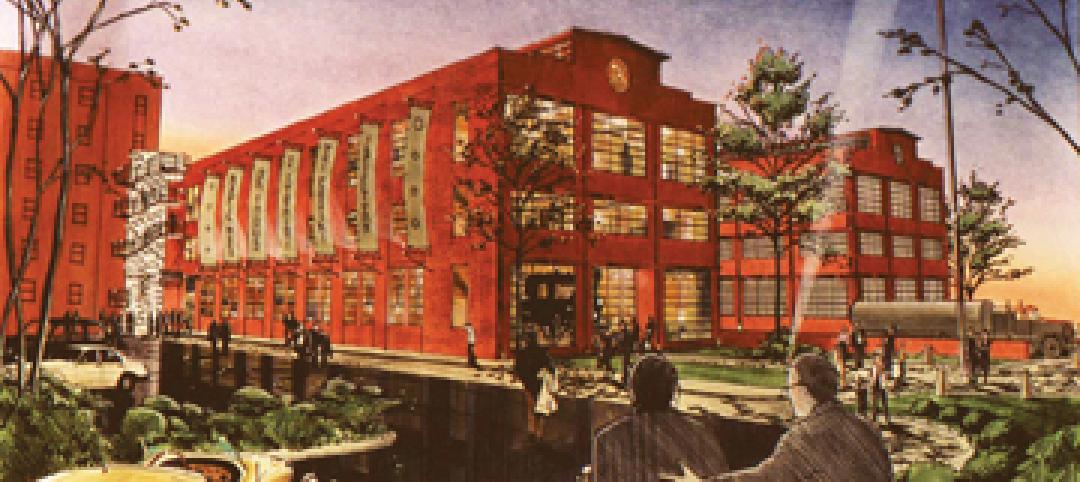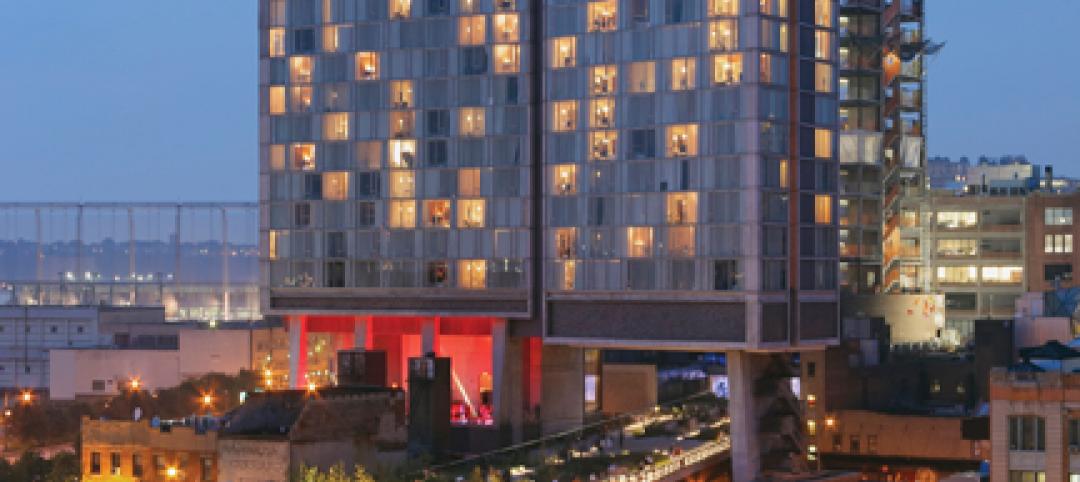Building Teams and their clients tend to think of a decorative concrete contractor as just another trade to be fit into the construction schedule, preferably at the lowest possible cost. But installing decorative concrete can be a delicate process, making planning for the construction crucially important.
At one time, decorative concrete came in only a few finishes—colored concrete, acid-etch stained, and stamped patterns. Today, there’s an almost infinite number of finishes available for horizontal and vertical surfaces—stamped, textured, integral and dust-on, colored, acid etch, dye (water and solvent), stampable overlays, self-level overlays, micro-toppings, stencil, engraved, form liners, diamond polished, sandblast, exposed aggregate, and coatings (epoxy, urethane, and acrylic). Finishes can also be combined with other finishes.
The possibilities are limited only by creativity of the designer and concrete contractor, yet it’s that very creativity that makes using decorative concrete so attractive. The problem is that concrete is very sensitive to a wide range of variables that can negatively impact the outcome.
ALSO SEE: 8 Innovations That Will Rock Your Next Concrete Project
To learn more about how to control these variables and thereby make decorative concrete a successful component of your next project, we consulted Mike Miller, Managing Principal of The concretist, Benicia, Calif. (www.theconcretist.com), one of the oldest decorative concrete contractors in the business. The term “concretist” refers to “one who practices concrete poetry,” and Miller himself is widely known for the almost poetic nature of his work.
1. Correctly assess—and manage—client expectations.
Miller says projects should start with the owner providing a full description, preferably in writing, of what the finished product should look like. Then the contractor can respond with what’s physically, aesthetically, and financially feasible. Sometimes owners have unreasonable expectations; early discussion can help manage those expectations.
What Building Teams should do when specifying decorative concrete:
1. Correctly assess—and manage—client expectations.
2. Choose the right decorative concrete contractor.
3. Carefully schedule the work of other trades to avoid undue damage to the concrete.
4. Provide the right protection for the finished work.
5. Negotiate an agreement with the client/owner on post-occupancy maintenance.
Decorative concrete usually isn’t structural in nature, although specifications are often written as if they were. For instance, a specification might require concrete with high compressive, tensile, or flexural strengths cured in a prescriptive manner. Or a specification might require “green concrete” with a certain percentage of the portland cement substituted with fly ash, slag cement, or other pozzolanic materials.
Miller’s advice: Focus first on the requirements for a good decorative installation; otherwise the work might meet all the structural requirements but be rejected for aesthetic reasons. For example, applying the usual curing specification for plain concrete to decorative work could have disastrous results, to the point of permanently damaging the look of decorative work. He urges Building Teams to use pre-job conferences to focus on the “dryness” of concrete or the slab relative humidity needed to start finish work rather than how to retain more moisture for curing purposes.
2. Choose the right decorative concrete contractor.
There can be significant variations in the creative abilities of decorative concrete contractors, says Miller. If you want highly creative work you must find a contractor who can perform at that level and who also possesses good craft skills. Contractors tend to specialize in certain types of decorative concrete these days, so you’ll have to narrow your search to get the right one for your job.
A word of caution: Miller says some decorative concrete contractors don’t place-and-finish concrete and wouldn’t know how to do it if asked, so you might have to hire a place-and-finish concrete contractor in addition to a decorative specialist.
3. Carefully schedule the work of other trades to avoid undue damage to the concrete.
Unfortunately, decorative concrete is highly susceptible to damage by other trades, more so than tile or other finished floor surfaces. Damage to concrete slabs can occur before decorative work begins or afterwards. Plumbers have been known to spill cutting oil, hot solder, and plastic pipe glue on slabs. Carpenters seem to think that any flat surface was put there so that they could pile stacks of lumber on it. Even trade workers’ footprints on floors that are hard but still considered “green” can become visible when acid-stain finishes are applied. Shoe soles also contain oils that may act as a resist.
To avoid conflicts with other trades, Miller recommends scheduling this work starting on a Friday afternoon and proceeding through a weekend. With no one on the job site to cause problems or delays, he says that’s the best chance for success.
4. Provide the right protection for the finished work.
The common belief about concrete is that it gets hard, becomes even stronger over time, and that’s pretty much it—no need to worry further. But that is not the case. Concrete remains vulnerable because its chemistry continues to change as it ages, and water on slab surfaces can bring about other physical and chemical changes. That’s why it’s so important to include a plan for protecting the finished work in pre-job meeting discussions.
Miller says covering material must allow moisture vapor from concrete to pass through while not allowing products that can stain to reach the surface of the concrete. The responsibility for the finished work is not a trivial matter. Since the concrete contractor cannot be expected to stay on the job until the concrete has fully cured, the responsibility for protecting the decorative work falls to the general contractor. However, that does not absolve the decorative contractor of all responsibility. The subcontractor should suggest the best protective products to use and perhaps even install them the first time.
5. Negotiate an agreement with the client/owner on post-occupancy maintenance.
A long-term maintenance plan should be part of the discussion your Building Team has with the client and facilities staff before construction begins. There are several ways to seal decorative work; each sealer provides a unique appearance. If an owner wants a glossy “wet look,” an epoxy, polyaspartic urethane, or acrylic finish is a good choice. These finishes must be renewed per the manufacturer’s recommendation. The accepted standard is that pedestrians should walk on the sealer, not on the concrete.
ALSO SEE: The world’s first building made from carbon-fiber reinforced concrete starts construction in Germany
If the owner wants a natural concrete look without a glossy appearance, there are penetrating sealers on the market that restrict pore openings so that dirt and other staining materials will not penetrate the surface.
Diamond-polished floors present additional maintenance problems. Owners typically want these floors to have a high-gloss shine, but dirt and fine grit become abrasive under foot traffic, dulling the surface gloss over time. Some big-box retail companies have maintenance programs to remove dirt and grit on a frequent schedule. In grocery stores food spillage must also be removed and cleaned as it occurs.
The inspirational aspect of decorative concrete
There are good reasons for the growing popularity of decorative concrete. It’s in our nature as humans to surround ourselves with creative expression and color; we like to be emotionally pleased by our environment.
Today, there are many more options for Building Teams to provide that kind of satisfaction through the use of decorative concrete. That’s why it’s important for Building Teams to work with their decorative concrete contractors to meet these heightened client expectations and ensure a long and useful life for these beautiful, inspiring surfaces. +
--
Joe Navsik, a freelance writer in the Chicago area, is a former editor at Concrete Construction magazine.
Related Stories
| Jan 19, 2011
Industrial history museum gets new home in steel plant
The National Museum of Industrial History recently renovated the exterior of a 1913 steel plant in Bethlehem, Pa., to house its new 40,000-sf exhibition space. The museum chose VOA Associates, which is headquartered in Chicago, to complete the design for the exhibit’s interior. The exhibit, which has views of five historic blast furnaces, will feature artifacts from the Smithsonian Institution to illustrate early industrial America.
| Jan 19, 2011
Baltimore mixed-use development combines working, living, and shopping
The Shoppes at McHenry Row, a $117 million mixed-use complex developed by 28 Walker Associates for downtown Baltimore, will include 65,000 sf of office space, 250 apartments, and two parking garages. The 48,000 sf of main street retail space currently is 65% occupied, with space for small shops and a restaurant remaining.
| Jan 19, 2011
Biomedical research center in Texas to foster scientific collaboration
The new Health and Biomedical Sciences Center at the University of Houston will facilitate interaction between scientists in a 167,000-sf, six-story research facility. The center will bring together researchers from many of the school’s departments to collaborate on interdisciplinary projects. The facility also will feature an ambulatory surgery center for the College of Optometry, the first of its kind for an optometry school. Boston-based firms Shepley Bulfinch and Bailey Architects designed the project.
| Jan 19, 2011
Extended stay hotel aims to provide comfort of home
Housing development company Campus Apartments broke ground on a new extended stay hotel that will serve the medical and academic facilities in Philadelphia’s University City, including the University of Pennsylvania and the Children’s Hospital of Philadelphia. The 11,000-sf hotel will operate under Hilton’s Homewood Suites brand, with 136 suites with full kitchens and dining and work areas. A part of the city’s EnergyWorks loan program, the project aims for LEED with a green roof, low-flow fixtures, and onsite stormwater management. Local firms Alesker & Dundon Architects and GC L.F. Driscoll Co. complete the Building Team.
| Jan 19, 2011
Large-Scale Concrete Reconstruction Solid Thinking
Driven by both current economic conditions and sustainable building trends, Building Teams are looking more and more to retrofits and reconstruction as the most viable alternative to new construction. In that context, large-scale concrete restoration projects are playing an important role within this growing specialty.
| Jan 10, 2011
Michael J. Alter, president of The Alter Group: ‘There’s a significant pent-up demand for projects’
Michael J. Alter, president of The Alter Group, a national corporate real estate development firm headquartered in Skokie, Ill., on the growth of urban centers, project financing, and what clients are saying about sustainability.
| Jan 7, 2011
BIM on Target
By using BIM for the design of its new San Clemente, Calif., store, big-box retailer Target has been able to model the entire structural steel package, including joists, in 3D, chopping the timeline for shop drawings from as much as 10 weeks down to an ‘unheard of’ three-and-a-half weeks.
| Jan 7, 2011
How Building Teams Choose Roofing Systems
A roofing survey emailed to a representative sample of BD+C’s subscriber list revealed such key findings as: Respondents named metal (56%) and EPDM (50%) as the roofing systems they (or their firms) employed most in projects. Also, new construction and retrofits were fairly evenly split among respondents’ roofing-related projects over the last couple of years.
| Jan 7, 2011
Total construction to rise 5.1% in 2011
Total U.S. construction spending will increase 5.1% in 2011. The gain from the end of 2010 to the end of 2011 will be 10%. The biggest annual gain in 2011 will be 10% for new residential construction, far above the 2-3% gains in all other construction sectors.
















